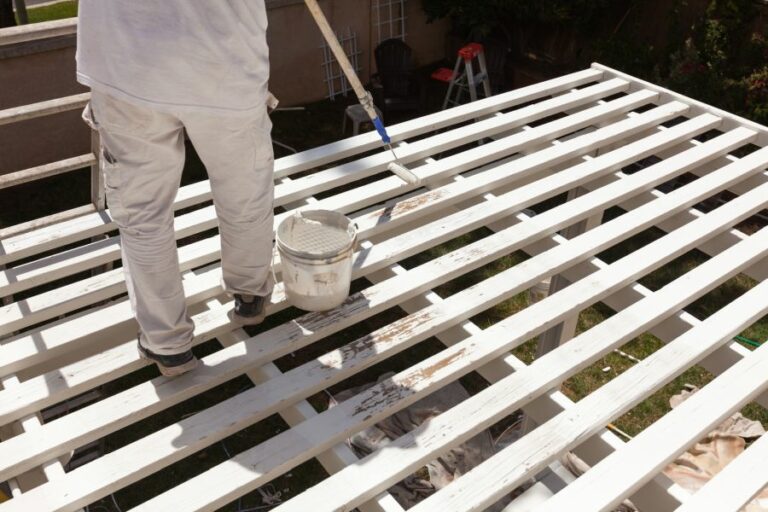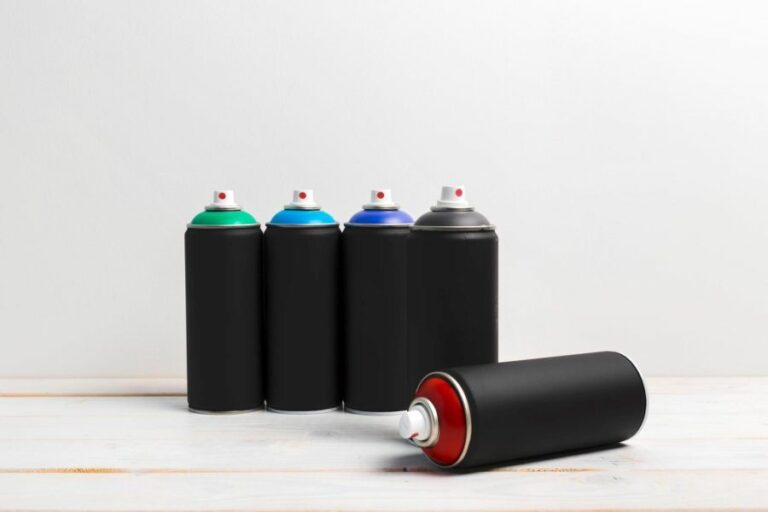Colors To Paint Outdoor Shed, 25 Things You Should Know
Are you planning to spruce up your outdoor shed with a fresh coat of paint but unsure about the perfect color? Worry no more! I have covered you with the best selection of colors that will add life to your shed and complement the existing outdoor surroundings.
Colors to paint the outdoor shed:
The best colors to paint your outdoor shed include neutral colors like beige, cream, or gray for a minimalistic look, earth tones like dark brown, green, or deep ocher to blend with nature, classic greens for a harmonious feel, sophisticated grays for a modern touch, and bold colors like red, blue, or yellow for a focal point. When choosing a color, consider your home’s exterior, surrounding landscape, lighting, and paint quality.

Want to give your outdoor shed a fresh new look? Keep reading for a kaleidoscope of color ideas that can help transform and re-energize your shed. From trendy hues to classic shades, I’ve got it all covered! Dive in to discover your perfect palette!
Contents
- 1 Shades and Hues for Painting an Outdoor Shed
- 2 What are the suitable colors for painting a garden shed?
- 3 Which is the Most Suitable Paint for an Exterior Shed?
- 4 The Most Common Shed Color: Factors and Trends
- 5 Which Month Is the Most Ideal for Painting a Shed?
- 6 How can I enhance the aesthetic appeal of my outdoor shed?
Shades and Hues for Painting an Outdoor Shed
When it comes to painting your outdoor shed, choosing the right color can make all the difference. A shed can either blend seamlessly with its surroundings or stand out as a focal point in your garden. Here are the best colors to paint your outdoor shed, along with some tips on how to choose the most appropriate color for your needs.
• Neutral Colors: Let Your Shed Blend In
If you prefer your garden shed to blend seamlessly with its surroundings, neutral colors are a great choice. These include shades of beige, cream, and gray. Not only do they allow your shed to recede into its environment, but they also offer a clean, minimalistic look.
– Earth Tones: Connect with Nature
Earth tones are an excellent option for blending your shed with the environment. Colors like dark brown, green, and deep ocher capture the natural hues found in plants and rich soil, allowing your shed to become part of the landscape.
Michigan State University’s recommendations on Earth tones offer great advice on how to choose the right earth tones to match your home’s exterior and the surrounding environment.
Green: A Classic Choice
Green is a popular color for garden sheds, and it’s easy to see why. Offering a sense of tranquility, the color ranges from mint green to deep forest shades. A green shed can harmonize with the plants and trees in your garden, creating a cohesive outdoor space.
– Grays: Sophistication and Modernity
Grays are an exceptional option for homeowners who desire a classic yet modern look. Light gray shades create an understated elegance, while darker tones, such as charcoal or slate, can make a bold statement. Adding contrasting white or black trims can further enhance your shed’s architectural appeal.
• Bold Colors: Make Your Shed a Focal Point
Some people want their garden shed to stand out in their yard, transforming the space into a focal point. Bold colors, such as reds, blues, and yellows, can accomplish this.
– Red Sheds: Vibrancy and Drama
Red is a color that catches the eye and adds drama to any space. A red shed can be an excellent addition to a garden with vibrant flowers and contrasting foliage. Ranging from classic barn red to bright berry shades, the color stands out and makes a statement.
– Blue Sheds: Serenity and Coastal Cool
Blue sheds evoke a sense of serenity and have a coastal charm. From pale sky blues to deep, moody navy hues, a blue shed can create a calming atmosphere in your garden. Pairing this color with white or off-white trims can create a crisp, nautical look that enhances your outdoor space.
– Yellow Sheds: Sunshine and Happiness
A yellow shed can brighten up your garden, creating a sunny and cheerful atmosphere. The effect can be subtle or bold depending on the shade you choose. From soft, buttery hues to bright, sunshine yellows, this color can make your shed a joyous addition to your yard.
• Tips for Choosing the Right Color
Before settling on a color, consider the following tips to ensure your shed complements your home and garden.
– Consider Your Home’s Exterior
The color of your shed should harmonize with your home’s exterior, creating a cohesive look. Take cues from the primary color of your home and any accent colors used for trim, shutters, and doors.
– Factor in the Surrounding Landscape
Take inspiration from the surrounding landscape, including any large trees, vibrant plants, and the overall color story present in your yard. This will make your shed an integral part of the garden rather than an eyesore.
– Test Out Colors
Before committing to a color, obtain samples and paint swaths on your shed in different lighting throughout the day. Colors can change based on the time of day and the angle of sunlight, so it’s essential to see how your chosen color looks in various lights before making a final decision.
– Obtain Quality Paint
Investing in quality exterior paint will ensure long-lasting color and protection. High-quality paint is less likely to fade, chip or peel under the elements, keeping your shed looking fresh and well-maintained.
In conclusion, whether you’re leaning toward a neutral, earth-tone, or bold color for your outdoor shed, taking the time to consider how the color fits into your existing landscape and complements your home’s exterior can lead to a beautiful, cohesive result. Happy painting!
What are the suitable colors for painting a garden shed?
When it comes to painting a shed, selecting the right colors can make a significant difference in the overall appearance and feel of your outdoor space.
• Factors to Consider When Selecting Shed Colors
– Purpose of the Shed
Before choosing a color for your shed, consider its primary purpose. This can help you narrow your color choices and ensure the shed will blend seamlessly into its surroundings.
- Storage: If the shed’s primary function is for storage or general use, you may want to choose neutral colors like beige, gray, or white. These colors will allow the shed to blend in with its surroundings and not attract too much attention.
- Workshop or Home Office: For a shed that will be used as a workshop or home office, consider your chosen color’s impact on your mood and productivity. Blues and greens are known to create a calm and focused atmosphere, whereas yellows and oranges can help inspire creativity.
- Garden Retreat or Playhouse: If your shed serves as a garden retreat or playhouse, you may want to choose more vibrant or playful colors like pastel shades or rich, earthy tones to create a cozy, inviting atmosphere.
– Location of the Shed
Another factor to consider when choosing a shed color is its location within your property. The color should complement the existing landscape and house colors/mood.
- Garden Backdrop: If your shed is situated among trees and foliage, consider using earth-toned colors like hunter green, brown, or tan to help it blend in with the natural surroundings.
- Architectural Focal Point: If the shed serves as an architectural focal point within your yard, select a color that complements the main color of your house or matches your outdoor furnishings.
– Sunlight Exposure
The amount of sunlight your shed receives may also impact your color choice. Dark colors absorb more heat, whereas light colors help keep the shed cooler in high sunlight areas.
• Color Inspirations and Combinations
Here are some popular color combinations to consider when painting your shed:
- Classic White: A tried, and true option, a white shed can pair well with any house color or landscape. Consider using a contrasting color for trim, doors, or window frames to add interest.
- Earthy Tones: Browns, greens, and tans blend beautifully with garden surroundings, creating a harmonious balance between the shed and nature.
- Bold and Colorful: Don’t be afraid to add a pop of color to your shed. A bright red, blue, or yellow can serve as a focal point in your yard and showcase your unique style.
- Neutrals and Pastels: Light grays, beiges, or soft pastels can create an inviting and visually pleasing calming atmosphere.
• Painting Materials and Preparation
Experienced painters know that proper preparation and using the right materials can make all the difference in the final result.
– Choosing the Right Paint
Select a paint designed specifically for exterior use to ensure durability and weather resistance. Look for paints that offer UV protection, mildew resistance, and a long-lasting finish.
For more detailed information on selecting the best paint for your shed, consider visiting a .gov site like EPA.gov for guidance on environmentally-friendly options.
– Preparing the Shed Surface
Before applying paint, be sure to clean and prepare your shed’s exterior surfaces. Sand down any rough or peeling patches and fill in any gaps or cracks with an exterior wood filler.
Then, wash the entire shed with a mild detergent and water, giving special attention to removing any mold, mildew, or debris. Allow the shed to dry completely before applying paint.
– Applying Primer
To ensure the best adhesion and coverage, apply a high-quality exterior primer to the shed prior to painting. This step will also help to prevent knots or discoloration in the wood from showing through the finished paint job.
– Painting Techniques
Use a combination of brushes and rollers for the most efficient and effective paint application. A brush is particularly useful for detailing trim, doors, and corners, while a roller allows for smoother and more even coverage on larger surfaces.
• In Conclusion
Choosing the perfect colors for your shed involves considering various factors, such as the shed’s purpose, location, and sunlight exposure. Opt for complementary colors that blend with your home’s existing color scheme and landscape.
Be sure to choose quality exterior paint and follow proper surface preparation techniques for a long-lasting and visually appealing finish. Considering these considerations, your newly painted shed will be an exceptional addition to your outdoor space.
Which is the Most Suitable Paint for an Exterior Shed?
If you own an outdoor shed, you know how important it is to keep it well-maintained and protect it from the elements. One of the best ways to ensure your shed remains durable and looks great for years is to coat it with the right paint.
• Types of Paint for Outdoor Sheds
There are three main types of paint that work well for outdoor sheds: latex, oil-based, and acrylic. Here’s a brief overview of each kind:
– Latex Paint
Latex paint, also known as water-based paint, is commonly used for outdoor applications due to its resistance to fading, durability, and easy application. By drying quickly, it allows you to apply multiple coats within a short timeframe, making the painting process efficient.
The water-based nature of latex paint makes it easy to clean up with soap and water, which is an added benefit for DIY homeowners.
– Oil-based Paint
Oil-based paint offers excellent durability and is resistant to moisture, making it a suitable option for outdoor sheds. However, its slow-drying nature can extend the painting process and requires additional preparation, such as priming, before application.
Moreover, oil-based paint produces strong fumes, which may not be ideal for everyone. You’ll need to use mineral spirits or paint thinner for cleanup, which can be less environmentally friendly and more tedious than latex paint.
– Acrylic Paint
Acrylic paint, a popular choice for outdoor sheds, is essentially a more advanced version of latex paint. These paints provide excellent UV resistance, maintaining their color for a long time, and they are highly durable.
Unlike oil-based paint, acrylic paint is low-odor and easily cleaned up with soap and water. Acrylic paint is often recommended for its long-lasting performance and resistance to harsh weather conditions.
• Factors to Consider When Choosing the Best Paint for Your Shed
When selecting the best paint for your outdoor shed, it’s crucial to consider the following factors:
– Climate
Your location’s climate plays an essential role in determining the most suitable paint for your shed. If you live in an area with high humidity, you should opt for paint with excellent moisture resistance, such as oil-based or acrylic paint.
Choose a paint that can withstand contraction and expansion in areas with extreme temperature fluctuations, such as acrylic paint.
– Shed Material
The shed’s material will also affect your choice of paint. Latex and acrylic paints are most suitable for wooden sheds, as they allow the wood to breathe, preventing moisture from getting trapped underneath the paint. Oil-based paint should be avoided on wooden sheds, as it can cause the wood to rot.
On the other hand, a metal shed requires paint that can effectively adhere to the surface and protect it from rust. Acrylic paint is an excellent option for metal sheds, as it offers superior adhesion and rust prevention.
– Finish Preference
Some paints are available in various finishes, such as matte, satin, or glossy. Your choice of finish will depend on your preference and your shed’s desired appearance.
For instance, a matte finish offers a more subtle look, while glossy paints can create a more vibrant appearance and provide added protection against the elements.
– Environmental Impact
If you’re concerned about your paint’s environmental impact, consider choosing a paint with low VOC levels (volatile organic compounds). Low-VOC paints release fewer harmful chemicals into the environment, making them a more eco-friendly option.
Latex and acrylic paints tend to have lower VOC levels compared to oil-based paints.
• Recommended Paints for Outdoor Sheds
Based on the factors we’ve discussed above, I recommend using the following paints for your outdoor shed:
- For wooden sheds: Choose a high-quality latex or acrylic paint with UV and moisture resistance. One such recommendation is Behr Premium Plus Exterior, which provides excellent durability and is available in multiple finishes.
- For metal sheds: Opt for a rust-inhibiting acrylic paint, such as Rust-Oleum Stops Rust, which is specifically designed for metal surfaces and offers excellent protection against rust.
- For eco-friendly options: Choose a low-VOC paint, such as Benjamin Moore’s Natura, which has zero VOC emissions and is environmentally friendly.
• Preparing and Painting Your Shed
Before you begin painting your shed, it’s essential to prepare the surface properly. Here are the key steps for surface preparation and painting:
- Remove any dirt, debris, and mildew from the shed using a pressure washer or scrub brush.
- Scrape off any loose or peeling paint.
- Repair any damages, such as replacing rotten wood or filling in holes and gaps with caulk.
- If necessary, prime the shed’s surface with a high-quality primer, especially when using oil-based paint.
- Apply the paint using a brush, roller, or sprayer, depending on the size of the shed and the type of paint you’ve chosen.
- Allow the paint to dry completely between coats, following the recommended drying times on the paint’s label.
- Apply a second coat, if necessary, to achieve the desired coverage and appearance.
• Conclusion
When painting your outdoor shed, choosing the right type of paint is crucial for its looks and longevity. By considering factors such as climate, shed material, finish preference, and the environment, you can make an informed decision on the best paint for your specific needs.
Remember, proper surface preparation and application are just as important as selecting the right paint to ensure a long-lasting and durable finish for your shed.
Brand | Type | Color Options | Features |
|---|---|---|---|
Behr Premium | Exterior Latex Paint | Variety of Colors | Weather-resistant, mildew-resistant, UV protection |
Rust-Oleum | Exterior Enamel Paint | Variety of Colors | Weather-resistant, rust-resistant, long-lasting finish |
Sherwin-Williams | Exterior Acrylic Paint | Variety of Colors | Water-resistant, mildew-resistant, UV protection |
Benjamin Moore | Exterior Latex Paint | Variety of Colors | Weather-resistant, mildew-resistant, long-lasting finish |
Valspar | Exterior Latex Paint | Variety of Colors | Weather-resistant, durable, easy to apply |
The Most Common Shed Color: Factors and Trends
A well-designed and appropriately colored shed can add aesthetic value to a property and serve its functional purpose. When it comes to choosing a color for a shed, homeowners may wonder, “What is the most common shed color?”
I will discuss the various factors that influence shed color choices, trends relating to popular colors, and recommendations for selecting the perfect shade for your shed.
• Factors Impacting Shed Color Popularity
There are several factors that can impact the popularity of a specific shed color among property owners. These include:
– Surrounding Environment and Architectural Style
The surrounding environment plays a major role in the choice of shed color. In rural areas, for instance, earthy and muted colors are often preferred to blend in seamlessly with the natural landscape.
In urban neighborhoods, however, sheds may be painted to match the property’s main house or complement other aspects of the landscape or garden.
In addition, the architectural style of the property can also influence the choice of shed color. For example, a traditional, cottage-style home may call for a classic white or cream shed, while a modern, minimalist property may look best with a sleek, black or gray shed.
– Material
Shed materials can also influence the choice of color. Popular shed materials like wood, metal, and vinyl each come with their own color options and finishing. For example, wood sheds can be stained or painted in various colors, while metal sheds may come pre-finished in a limited range of shades.
– Personal Aesthetic Preferences
Lastly, personal preferences play a significant role in shed color choice. Individual homeowners may lean toward certain tones based on their favorite colors or opt for something unique to create a stand-out space that reflects their style.
• Trends in Popular Shed Colors
Over the years, certain colors have become more popular for sheds than others. Below are some of the most commonly seen shed colors that continue to be a favorite among homeowners:
– Neutral Colors
Neutral colors, such as beige, gray, and off-white, are the top choice for many property owners. These shades not only blend effortlessly with various home styles, but also complement a wide variety of landscapes, making them a versatile option.
Neutral-colored sheds can also be easily updated by adding accents, such as colorful doors or window frames, to make the building stand out.
– Shades of Green
Greens, particularly earth-toned ones like olive, moss, or sage, are frequently used in rural settings. These colors help the shed blend into the natural surroundings and maintain a harmonious look with the environment.
Furthermore, earthy greens can work well with a wide range of architectural styles, from traditional to modern. The College of Agricultural Sciences at Colorado State University offers a useful guide on color theory and using natural colors in landscaping.
– Brown and Rustic Tones
Brown and rustic tones, such as barn red, are other popular choice for sheds. These colors are ideal for wooden sheds and lend the structure a traditional, classic look. Authentic barn-red paint, for example, can add a charming, vintage vibe to a wooden shed.
– Bold and Modern Colors
Some property owners prefer a more striking look for their shed by going for bold and modern colors like black, deep blue, or charcoal. Dark shades can create a sleek, sophisticated appearance, especially when paired with metallic elements like door handles and window frames.
• Recommendations for Choosing the Perfect Shed Color
When it comes to selecting the ideal shed color, consider the following recommendations:
- Coordinate with the main house: As a general rule of thumb, the shed color should complement the property’s existing color scheme and architectural style. This creates a cohesive and visually appealing look for your outdoor space.
- Consider the surrounding landscape: Choose a color that harmonizes with the colors of your yard or garden. Muted or earthy tones work well with natural settings, while bolder colors may be better suited to urban or modern landscapes.
- Factor in maintenance: Certain colors may require more frequent maintenance to keep them looking their best. Light-colored sheds may show dirt and wear more easily, while darker colors can fade over time due to sun exposure.
- Experiment with contrast and accents: Don’t be afraid to add contrasting accents or features, such as bright doors, window frames, or trim, to create visual interest and make your shed stand out.
In conclusion, while there is no one-size-fits-all answer to the question, “What is the most common shed color?” trends suggest that neutral colors, shades of green, browns, and rustic tones are among the most popular choices.
Personal preferences, surrounding environment, and architectural style ultimately play a crucial role in selecting the perfect shed color.
By considering these factors and recommendations, homeowners can find the ideal color to enhance their property and meet their individual aesthetic and functional requirements.
Which Month Is the Most Ideal for Painting a Shed?
• Understanding the Ideal Painting Conditions
When planning to paint a shed, it is crucial to consider specific factors that affect the outcome of the paint job, such as the temperature and humidity levels.
Experts say the ideal temperature range for exterior painting projects is between 50°F and 85°F, with optimal humidity levels below 60%. Painting under these conditions will ensure proper adhesion of the paint to the surface and adequate drying time.
Painting during extremely hot or cold weather can lead to various problems. Cold temperatures cause paint to thicken, making it difficult to spread evenly, while paint could dry too quickly in hot weather before completely adhering to the surface.
High humidity levels can also prevent the paint from drying properly, leading to a longer curing time and possible moisture-related issues.
– Choosing the Best Month for Your Region
The optimal month to paint a shed largely depends on the climate of the region you live in. Here is a general guide to choosing the best month for painting your shed based on regional climates:
- Mediterranean and Mild Oceanic Climates: For regions with mild winters and warm summers, such as the Mediterranean and some coastal areas, the best months for painting projects are from late April to June and September to early October. These months provide a balanced temperature range with limited rainfall.
- Temperate Continental Climates: In regions with cold winters and warm summers, like many parts of the United States and Europe, the ideal window is May to early June and September to early October. These months offer consistent warm temperatures and lower humidity levels.
- Subtropical and Tropical Climates: In areas with hot and humid climates, it’s best to plan the painting project during the cooler and drier seasons, which may vary depending on the region. Generally, the best months are from November to March.
It is essential to consider these guidelines for your region and monitor the weather patterns and forecasts for the specific month you plan to paint your shed. Unexpected weather changes can create unfavorable painting conditions and potentially compromise the quality of your paint job.
• Preparing Your Shed for Painting
Thorough preparation is crucial for a successful paint project. Take the time to perform essential preparation tasks before starting to paint:
- Clean the Shed: Start by cleaning the shed to remove any dirt, dust, mildew, or algae. A mixture of warm water, mild soap, or a specially formulated cleaning solution designed for exterior surfaces will suffice. Use a stiff brush or pressure washer to clean the surface thoroughly.
- Inspect for Damages: After cleaning, inspect the shed for any signs of damage, such as cracks, gaps, or wood rot. This is the perfect time to repair or replace damaged wood trim or siding.
- Sanding and Priming: Lightly sand the surface to remove any loose paint and create a smooth surface for the new coat of paint. After sanding, apply a quality primer, which helps ensure proper adhesion and a smoother finish.
- Choose the Right Paint: Invest in high-quality exterior paint, which will provide better durability and protection against the elements. Consider selecting a paint with mildew-resistant properties for added protection in humid climates.
– Additional Tips for Successful Shed Painting
- Monitor the Weather: Stay up-to-date with local weather forecasts during the painting project, adjusting your schedule as needed to avoid painting in extreme heat, cold, or rain.
- Timing: Begin painting your shed early in the day to take advantage of the most favorable temperatures and to ensure enough drying time before evening dew sets in.
- Prevent Drips: Apply paint with a brush or roller using even, vertical strokes to prevent visible drip marks.
- Add a Second Coat: For increased durability and coverage, consider applying a second coat of paint after allowing sufficient drying time between coats.
- Proper Ventilation: Ensure adequate ventilation during and after painting, particularly when working with oil-based paint.
For more detailed information and guidance on exterior painting, consult resources like the Paint Quality Institute, a non-commercial organization backed by industry experts dedicated to providing practical knowledge on paint, coatings, and related subjects.
• Conclusion
In conclusion, choosing the best month to paint a shed depends on the climate, region, and local weather patterns.
Understanding the ideal painting conditions, properly preparing the shed, monitoring weather conditions, and adhering to expert recommendations will all contribute to a successful shed painting project.
Month | Weather Conditions | Suitability for Painting |
|---|---|---|
January | Cold and snowy | Not suitable |
February | Cold and snowy | Not suitable |
March | Spring weather, possible rain | Less suitable |
April | Spring weather, possible rain | Less suitable |
May | Warm and dry | Most suitable |
June | Warm and dry | Most suitable |
July | Warm and dry | Most suitable |
August | Warm and dry | Most suitable |
September | Warm and dry | Most suitable |
October | Fall weather, possible rain | Less suitable |
November | Fall weather, possible rain | Less suitable |
December | Cold and snowy | Not suitable |
How can I enhance the aesthetic appeal of my outdoor shed?
An outdoor shed can be more than just a place for storage. With some simple design tweaks and a bit of creativity, you can transform your shed into a visually appealing and functional space.
• Choosing the Right Exterior Paint
The first step in improving the appearance of your shed is to choose the right paint colors. A fresh coat of paint can do wonders for the overall look of your outdoor shed. When selecting a paint color, consider the following:
- Complementary colors: Choose a color that will complement the colors of your house and garden. This will create a sense of cohesion between the structures and make your shed blend in with its surroundings.
- Durability: Opt for a high-quality, weather-resistant paint that will withstand the elements and maintain its appearance over time.
For more information on selecting the right paint for your shed, check out this helpful guide from Consumer Reports.
• Landscaping Around Your Shed
Thoughtful landscaping can greatly improve the appearance of your outdoor shed. Here are some ideas for creating an eye-catching landscape around your shed:
– Adding Flower Beds
Flower beds around your shed can add color, texture, and visual interest to your garden. Some colorful flowers, like marigolds or pansies, can make your shed look more attractive.
– Planting Climbing Vines
Planting climbing vines, like clematis or ivy, against your shed can create a beautiful, natural backdrop. As the vines grow and cover the exterior walls, they can create a more organic and inviting atmosphere.
– Installing Garden Pathways
A garden pathway leading up to your shed can add a functional and visually appealing touch. Consider using materials like pavers, gravel, or mulch to create a pathway that compliments your shed’s appearance.
• Enhancing the Shed’s Roof
A neglected or damaged roof can detract from your shed’s overall appearance. Consider these options to enhance your shed’s roof:
– Replacing or Repairing Roof Shingles
If your shed’s roof is in poor condition, you may want to consider replacing or repairing the shingles. This will improve the shed’s appearance and protect the contents inside from weather-related damage.
– Adding a Green Roof
A green roof of low-maintenance plants and grasses can be an attractive and environmentally-friendly addition to your shed. For more information on green roofs, visit the [Environmental Protection Agency] (https://www.epa.gov/soakuptherain/what-green-roof) website.
• Installing Attractive Shed Doors and Windows
The doors and windows of your outdoor shed can significantly impact its appearance. Consider the following enhancements to improve the look of your shed’s windows and doors:
– Replacing Old Doors
A new shed door can instantly update your shed’s overall look. Choose a door style that complements your shed’s paint color and the surrounding landscape.
– Installing Decorative Window Boxes
Window boxes filled with colorful flowers or foliage can add charm to your shed’s windows. Coordinate the window box colors with your shed’s paint color for a cohesive look.
– Adding Window Shutters
Installing window shutters can enhance the aesthetic appeal of your shed while also providing added protection from the elements. Choose shutters in a color that complements your shed’s paint color.
• Lighting and Accessories
Lastly, don’t forget about lighting and accessories to create a cozy and inviting atmosphere around your shed. Here are a few ideas to consider:
– Outdoor String Lights
Hanging string lights around your shed can create a warm and welcoming ambiance. Choose lights in a style and color that complements your shed’s design.
– Outdoor Artwork
Placing outdoor artwork, like metal sculptures, wind chimes, or decorative plaques, can add personality and visual interest to your shed.
– Decorative Garden Tools and Equipment
Displaying decorative garden tools or vintage gardening equipment near your shed can create a charming and functional area that also serves as a conversation starter among guests.
By implementing these tips and recommendations, you can easily transform your outdoor shed from a simple storage space to a visually appealing and inviting garden feature. With a little creativity, you can make your outdoor shed look nice and be an attractive addition to your garden.







